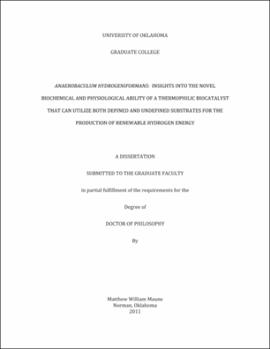| dc.description.abstract | This body of work describes the bacterium Anaerobaculum hydrogeniformans strain OS1, a novel anaerobic, moderately thermophilic, NaCl-requiring fermentative bacterium that was isolated from oil production water collected from Alaska, USA. A. hydrogeniformans produces 4 moles of H2 per mole of glucose. Aside from the characterization of A. hydrogeniformans, production of H2 from undefined wastewaters was also evaluated. An optimal ratio of wastewater to mineral medium was obtained for all feedstocks and used for batch fermentations. Clarified wastewaters resulted in higher H2 yields. This study shows that A. hydrogeniformans can be used to produce H2 from waste feedstocks while significantly reducing COD at values higher that others reported in the literature for pure and mixed cultures as well as electrolytic cells. Determination of the optimal fermentation conditions for A. hydrogeniformans and elucidate limiting factors during glucose fermentation. A. hydrogeniformans grew optimally and produced H2 from 0.2 M to 0.6 M, and tolerated up to 1.2 M NaCl, making it the most NaCl tolerant organism producing approximately 4 H2 per mole of glucose. A. hydrogeniformans was able to grow in the presence of high initial sodium/potassium acetate concentrations. Ionic strength was not responsible for inhibition of growth or product production. Inhibition of total glucose oxidation was affected by a decrease in the culture pH, where by pH adjustment with additional buffer or bicarbonate during growth resulted in total glucose oxidation. Hydrogen removal from the headspace marginally increased glucose utilization and growth rates, but the total H2 production rate was not affected. Glucose was not oxidized totally, in cultures with lowered H2 partial pressures, supporting the hypothesis that increasing H2 partial pressure is not the only limiting factor during fermentation. Growth rate and glucose utilization increased when the concentration of yeast extract was increased in the medium. The physiological pathway for anaerobic glucose oxidation was evaluated. Enzyme activities for the Embden-Meyerhoff-Parnas pathway were all detected. However, Glyceraldehyde-3-phosphate dehydrogenase was not be detected in cell free extracts of A. hydrogeniformans using NAD<sup>+</sup> or NADP<sup>+</sup> as electron acceptors. However there was enzyme activity for a glyceraldehyde-3-phosphate oxidoreductase. The oxidation of pyruvate to acetate is accomplished by a pyruvate:oxidoreductase, phosphotransacetylase and acetate kinase. Labeling of the C-1 and C-3 of glucose showed the production of CO2 from the 3-C of glucose and the incorporation of the C-1 of glucose into the methyl position of acetate, which is indicative of the Embden Meyerhof pathway and further confirmed by the detection of key metabolites from glucose grown cultures of A. hydrogeniformans. This is the first report of an eubacterial species that oxidizes glucose to acetate, H2 and CO2 via a ferredoxin dependent pathway, such as that previously thought to only be present in hyperthermophilic archaeal species. | |
